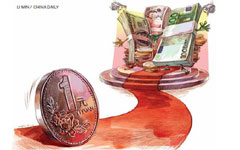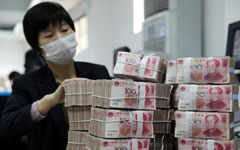Economic slowdown, US QE tapering frustrate strong yuan
(Xinhua) Updated: 2014-02-21 10:55Zong Liang, an international finance researcher at Bank of China, said that capital is flowing back to developed markets from emerging markets, after the US started to wind down assets purchase by $10 billion each month starting in January.
|
 |
|
 |
The Philippine's central bank said on Saturday that the Fed's decision resulted in a massive outflow of foreign portfolio investment from the country in January as "investors started to divert funds back to the US".
However, analysts said the tapering may also prove a valuable opportunity for China to progress reforms of the yuan's exchange rate regime.
China's central bank announced in mid-2010 that it would further promote the reform of the RMB exchange rate regime and increase the flexibility of the RMB exchange rate.
The Chinese central bank also said on Wednesday that it will gradually improve the yuan exchange rate formation mechanism and widen the bands for the yuan's floating.
In China's foreign exchange spot market, the yuan is allowed to rise or fall by 1 percent from the central parity rate each trading day.
The central parity rate of the yuan against the US dollar is based on a weighted average of prices before the opening of the market each business day.
|
 |
 |
| China's top 10 richest cities |
- NHTSA says finds no 'defect trend' in Tesla Model S sedans
- WTO rare earth ruling is unfair
- Amway says 2014 China sales may grow 8%
- President Xi in Europe: Forging deals, boosting business
- CNOOC releases 2013 sustainability report
- Local production by Chery Jaguar Land Rover this year
- Car lovers test their need for speed in BMW Mission 3
- China stocks close mixed Monday

















